"Awesome Artichokes"
March 19, 2009
- Vol 1, Issue 3
| |
|
Updated
Website
|
If you haven't visited our website lately, take a
look. We are updating and expanding our site
daily. I think you will enjoy the changes.
|
E-Newsletter
Drawing
|
If you receive our newsletter, you will be
entered into a drawing each month for a great prize for
your kitchen. Check here each month to see if you
have won, if so, come in to collect your
prize!
Feb's winner: Amber
White
Amber won a personalized Coozie......Congrats
Amber! | |
|
Harbinger of
Spring
|
Hang out in the produce department during March
and you'll easily overhear - "What's this?" Or perhaps,
"How do you cook these?" Or, "How do you eat it?"
Artichokes, the culinary equivalent of the first robin
of spring, are one of the most delectable vegetables
around in our opinion. They have a unique, delicate
taste that's irreproducible by any cook's alchemy. We've
all had them -- on pizza, in dips, in a pasta sauce --
but tackling a fresh one seems akin to butchering one's
own cow in order 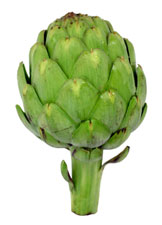 to get a steak! Fortunately, it's
not nearly that difficult. Artichoke growers are
reporting a "heavier than usual" harvest this year due
to favorable weather conditions. In this issue we'll
dissect an artichoke for you, demystify how to prepare
and eat fresh artichokes, and answer questions about
tools used in preparing artichokes and other spring
vegetables. We finish with three recipes that showcase
artichokes in some contemporary
presentations. to get a steak! Fortunately, it's
not nearly that difficult. Artichoke growers are
reporting a "heavier than usual" harvest this year due
to favorable weather conditions. In this issue we'll
dissect an artichoke for you, demystify how to prepare
and eat fresh artichokes, and answer questions about
tools used in preparing artichokes and other spring
vegetables. We finish with three recipes that showcase
artichokes in some contemporary
presentations. |
March
Wine of the Month
|
 This month we're
featuring: 2006
337 Cabernet Sauvignon 337 Wine
Vineyards Lodi, California Regular
Price: $17.00March
Price:
$11.00WOW!
A
spectacular Cabernet at an incredible
price!
If you'd like to read more about it,
check these tasting
notes.
Lolita and
Santa Barbara Design Glasses
are back
in stock!
Your favorite designer bar
glasses are back including a few new designs.
Available in Wine, Champagne, Beer, Martini, and
Decanter styles.
|
Beer Tasting Results
|
If
you missed our free beer tasting during last Saturday's
Clearance Sale, we feel sorry for you. But hope is
not lost; we now stock and sell the beer because it is
so good. We tasted 3 styles from Colorado Brewery,
Oskar Blues. Their claim to fame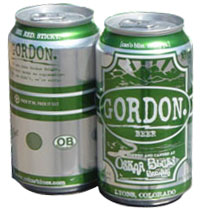 is that "good beer can come in a
can". The overwhelming favorite was
Gordan's. At $2.50 a can, it is the priciest, but
worth every penny. For more information about
Oskar Blues beers go to www.oskarblues.com is that "good beer can come in a
can". The overwhelming favorite was
Gordan's. At $2.50 a can, it is the priciest, but
worth every penny. For more information about
Oskar Blues beers go to www.oskarblues.com
Join us
for our free Wine Tasting during our Saturday Clearance
Sale on March
28th. | | |
|
Save 25% 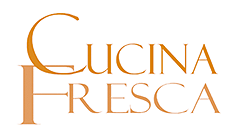
|
The Easter Bunny has arrived at our
store and has left all kinds of special items and treats for
you to discover! To help you help the Easter Bunny,
we're offering this coupon. So hop on over!
Present this
coupon to receive 25% off any Easter-themed
merchandise.
|
|
Offer Valid March 19, 2009
through April 11, 2009 |
Don't Miss this March
Event!
|

We're clearing out old
merchandise and making room for spring and summer!
Join us
every Saturday in March for incredible savings on your
favorite kitchenware brands:
Saturday March
21st: Featuring: Seasonal
Items Saturday March
28th: Featuring: Certified International
Retiring Tabletop patterns
Bonus:
Free Wine Tasting
New merchandise and additional
savings will be added each
Saturday! |
Anatomy of an
Artichoke
|
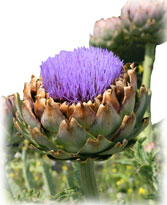 A staple ingredient of Mediterranean
cuisine, nearly all American artichokes are grown within a
fifteen mile radius of Castroville, California, the "Artichoke
Capital of the World." Located south of San Francisco in the
Salinas Valley, Castroville has built it's identity around the
artichoke in creative ways; you can join the 50th Annual Artichoke Festival
this year on May 16 - 17, 2009. A staple ingredient of Mediterranean
cuisine, nearly all American artichokes are grown within a
fifteen mile radius of Castroville, California, the "Artichoke
Capital of the World." Located south of San Francisco in the
Salinas Valley, Castroville has built it's identity around the
artichoke in creative ways; you can join the 50th Annual Artichoke Festival
this year on May 16 - 17, 2009.
Understanding the
structure and components of an artichoke is the first step to
reaping their enjoyment. An artichoke is the flower bud of a
perennial thistle plant. Strong stems support the
formation of several flower buds per plant early each spring.
A second, smaller harvest occurs in the fall. Newer, annual
varieties have recently spawned a year-round artichoke crop.
If left unharvested, the artichoke would turn into a large,
violet-blue thistle flower. But, before the bud opens to
flower, the artichoke is plucked for the kitchen.
The artichoke harvest furnishes
fresh artichokes for the produce market and plenty of
artichokes for canning and freezing. Processed
artichokes, available all year-round, show up as whole hearts,
quartered hearts, or as artichoke bottoms.
At just 25 calories per whole,
large artichoke, they are nutritional dynamos!
Artichokes have the USDA's "superfood" status; they rank
seventh out of 1000 common foods for their
total-antioxidant-capacity-per-serving.
|
How to Prepare and Eat an
Artichoke
|
Wrangling
a fresh artichoke can be a bit intimidating, but after one
encounter you'll be an expert!
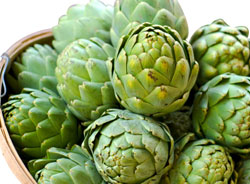 Choosing
a Fresh Artichoke - Choose an artichoke that is fresh
in appearance and feels heavy for its size. Minor brown
or white spots on the outer leaves are inconsequential, but
the artichokes should not appear dehydrated. A really
fresh artichoke will have "squeaky leaves" when rolled between
your hands. Artichokes come in various sizes:
Jumbo (softball-size), Large (baseball-size), Medium (tennis
ball-size), and Baby (golf ball-size). Once purchased,
store them in an airtight plastic bag in your refrigerator's
vegetable section. Choosing
a Fresh Artichoke - Choose an artichoke that is fresh
in appearance and feels heavy for its size. Minor brown
or white spots on the outer leaves are inconsequential, but
the artichokes should not appear dehydrated. A really
fresh artichoke will have "squeaky leaves" when rolled between
your hands. Artichokes come in various sizes:
Jumbo (softball-size), Large (baseball-size), Medium (tennis
ball-size), and Baby (golf ball-size). Once purchased,
store them in an airtight plastic bag in your refrigerator's
vegetable section.
Preparing
a Whole Artichoke for Cooking - Cut the stem of a jumbo
or large artichoke to about 1-inch in length, or flush with
its bottom if your final presentation calls for an "upright or
standing" artichoke. Remove the small leaves along the
stem and a few of the outermost leaves by snapping them off at
the base. Using a serrated knife, cut the top of the
artichoke away. Trim the tips of the remaining leaves
with kitchen shears to remove the sharp thorns. Rub the
cut edges of the artichoke with lemon, or immerse the entire
artichoke in a bath of acidulated water. View a
video.
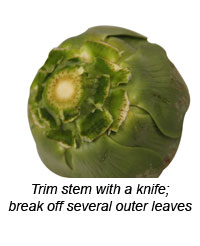 Cooking an Artichoke - Large
or jumbo artichokes may be prepared in a variety of
methods: Cooking an Artichoke - Large
or jumbo artichokes may be prepared in a variety of
methods:
Steaming - using
a steamer basket in a large pot, place the artichokes
stem-side down beside each other. Steam for 30 to 50
minutes; adjust the time according to the size and number of
artichokes. Check the water level periodically to ensure
enough steam and to avoid a dry pot. Insert the tip of a knife
into the thickest portion of the heart to test for
doneness.
Boiling -
place prepped artichokes in a pot of boiling, salted water for
25 to 40 minutes or until tender. Adjust time according to the
size and quantity of the artichokes.
Microwaving
- using a microwave safe bowl, place the artichokes in 1-2
inches of water. Cover with a plate or vented plastic
wrap. For jumbo artichokes, cook on high for 12-15
minutes; for medium-sized artichokes, 7-10 minutes.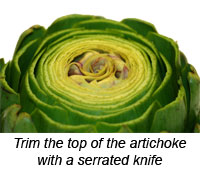
Grilling
- to grill artichokes, boil, microwave, or steam the
artichokes first. Halve the artichokes; brush the cooked
artichokes with olive oil, and place on the grill, turning at
least once. Grill until nicely browned and suitably
branded with grill marks.
Roasting
- to roast artichokes, boil, microwave, or steam the
artichokes until not quite tender -- 10 minutes shy of
doneness. Drain, brush with olive oil and bake in a hot
oven (400-425° F) for 10-20 minutes, or until tender and
lightly browned.
How to Eat a Fresh, Whole
Artichoke - For such a large vegetable, only a small
portion of the artichoke is edible: the heart, the
inside of the stem, and the small pithy portion of each leaf
that attaches to the heart. Serve one whole artichoke
per person.
Accompaniments
for Artichokes - As a native of the Mediterranean, the
artichoke blends perfectly with other flavors of the region.
And, if there's an arranged marriage to be made with an
artichoke, it's with the lemon. Begin with using a lemon to
rub the cut edges of the artichoke to decrease any
browning. Artichokes may be boiled in water with lemon
added, or for added flavor, boil artichokes in broth.
Serve whole artichokes with individual side dishes of sauce
for dipping. Some of our favorite sauces include
Hollandaise, Creamy Garlic, Greek Style dressings, melted
butter, or even mayonnaise-based sauces.
|
Spring
Vegetable Prep
|
One of
the best parts of spring is the reintroduction of the season's
produce. Along with asparagus, spring onions, and tender
greens, artichokes prognosticate the summer bounty ahead.
Dazzled by their reappearance and fresh colors, we renew our
vow to "eat more veggies!" Gear up for the season with
tools that will make vegetable preparation easy and
quick.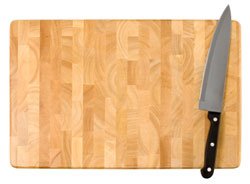
Cutting Boards - An abundance
of cutting board styles and sizes are available for the
garden-conscious kitchen. A basic kitchen will have multiple
cutting boards available for different preparation steps. Keep
at least one board exclusively for onion and garlic
prep. A small 5 x 8" board works well for small
jobs, and a larger 10 x 14 handles most other tasks. Wood,
bamboo, and plastic composite are the most commonly available
material choices for cutting boards.
 Knives - Sharp knives in a
size and shape suited to the task are a necessity. For
most vegetable prep, a 4-inch paring knife is an all-around
tool - large enough to handle the task, yet small enough for
dexterity and finessing. We also recommend a serrated
vegetable knife that you'll find indispensable for cutting
tomatoes, stone fruits and much more. Knives with a
ceramic blade eliminate the oxidizing/browning reaction
incited by a metal blade. A plastic lettuce knife makes
quick work of green, leafy bunches. Knives - Sharp knives in a
size and shape suited to the task are a necessity. For
most vegetable prep, a 4-inch paring knife is an all-around
tool - large enough to handle the task, yet small enough for
dexterity and finessing. We also recommend a serrated
vegetable knife that you'll find indispensable for cutting
tomatoes, stone fruits and much more. Knives with a
ceramic blade eliminate the oxidizing/browning reaction
incited by a metal blade. A plastic lettuce knife makes
quick work of green, leafy bunches.
 Kitchen Shears - A pair of
scissors kept handy in your knife block simplifies so many
things in the kitchen. The thorny tips of artichoke
leaves are easily snipped, grape bunches portioned, chickens
parsed, twine cut to size, and so much more. Make sure
your kitchen shears come apart for easy, thorough
cleaning. Kitchen Shears - A pair of
scissors kept handy in your knife block simplifies so many
things in the kitchen. The thorny tips of artichoke
leaves are easily snipped, grape bunches portioned, chickens
parsed, twine cut to size, and so much more. Make sure
your kitchen shears come apart for easy, thorough
cleaning.
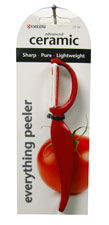 Brushes & Peelers -
Vegetables from the garden often require a good
scrubbing. Choose from handy palm brushes or brushes
with handles. Chose sturdy bristles for root vegetables,
and soft bristles for delicate foods such as mushrooms.
Peelers also come with multiple options. Most individuals find
a peeler with a double cutting edge the most valuable.
Like knives, a ceramic blade will keep the vegetable and metal
from reacting and turning the vegetable brown. Brushes & Peelers -
Vegetables from the garden often require a good
scrubbing. Choose from handy palm brushes or brushes
with handles. Chose sturdy bristles for root vegetables,
and soft bristles for delicate foods such as mushrooms.
Peelers also come with multiple options. Most individuals find
a peeler with a double cutting edge the most valuable.
Like knives, a ceramic blade will keep the vegetable and metal
from reacting and turning the vegetable brown.
 Colanders & Spinners -
Rinsing and draining vegetables is facilitated by a colander.
Many have discovered the collapsible colander that adjusts to
fit across your kitchen sink, then flattens for easy storage.
Salad spinners yield crisp, freshly dried greens that will
eagerly accept your freshly-made dressing. Colanders & Spinners -
Rinsing and draining vegetables is facilitated by a colander.
Many have discovered the collapsible colander that adjusts to
fit across your kitchen sink, then flattens for easy storage.
Salad spinners yield crisp, freshly dried greens that will
eagerly accept your freshly-made dressing.
Steamers - Hands-down, the
best way to preserve the nutritional value of vegetables is to
steam them. 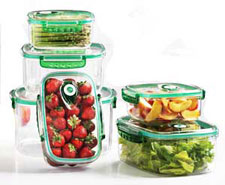 Steam cooks at a higher temperature
than boiling water while not diluting the food's
nutrients. Choose from silicone steaming baskets, or
adjustable metal steamers. Steam cooks at a higher temperature
than boiling water while not diluting the food's
nutrients. Choose from silicone steaming baskets, or
adjustable metal steamers.
Storage Containers - Keep
your produce fresh and maximize its shelf life with
vacuum-style containers. Place freshly purchased
vegetables in these containers and extend their usability by
several days. Or, try "green bags" that absorb
decay-provoking gases and allow your produce to remain fresher
longer.
|
Cucina Fresca's Smart
Artichoke Tips
|
Tip #1: Try one
of our favorite dips, the "C3." C3 stands for "a Cup, a
Cup, and a Can." Mix a cup of mayonnaise, a cup of
finely shredded Parmesan cheese, and o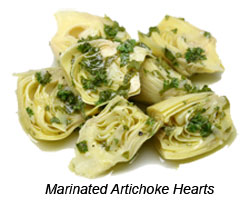 ne can of finely chopped artichoke
hearts. Place in a small baking or soufflé dish, and
bake at 350° F for 1 hour or until the top is just lightly
browned. Serve warm with your favorite crackers or thin
slices of baguette. ne can of finely chopped artichoke
hearts. Place in a small baking or soufflé dish, and
bake at 350° F for 1 hour or until the top is just lightly
browned. Serve warm with your favorite crackers or thin
slices of baguette.
Tip
#2: Marinated artichoke hearts are a popular
year-round way to enjoy artichokes. Use marinated
artichoke hearts on salad, pizza, pasta, or a pan of grilled
vegetable. Save the oil from the packed artichokes for
use in salad dressings or other vegetable
preparations.
Tip
#3: If your artichoke comes with a long stem,
trim off the first half inch and discard. Make a second
cut to leave the artichoke with a 1-inch stem, or nearly flush
with the bottom of the artichoke if you intend to "stand" your
artichoke when serving. Keep and cook the extra stem
pieces along with the artichokes and enjoy the stem's center
as a "cook's treat!"
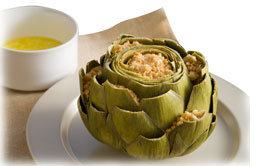 Tip
#4: Artichokes are a great "do-ahead" dish.
Artichokes may be steamed or boiled a day ahead of time, then
successfully reheated whether serving whole, grilled, or
roasted. Drain the cooked artichokes, set upside-down,
cover well, and refrigerate overnight. Tip
#4: Artichokes are a great "do-ahead" dish.
Artichokes may be steamed or boiled a day ahead of time, then
successfully reheated whether serving whole, grilled, or
roasted. Drain the cooked artichokes, set upside-down,
cover well, and refrigerate overnight.
Tip #5: Use a large or
jumbo artichoke as a bowl for sauces and dips. Cook the
artichoke, then gently pry the leaves open, remove the inner
choke, and place the sauce or dip in the
center.
|
Q &
A's
|
 Q: What is acidulated
water? Q: What is acidulated
water?
A: Many
vegetables and fruits will turn brown rapidly when their cut
surfaces are exposed to air in a process known as oxidation.
The browning, or oxidation may be reduced greatly by immersing
the food in water that has been amended with an acidic
component such as lemon juice or vinegar. The treated water is
known as acidulated water.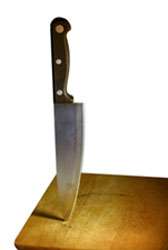
Q: Which is more
sanitary: wooden cutting boards or plastic cutting
boards?
A: There are
conflicting studies as to which material is actually more
sanitary. Wooden cutting boards have a natural
antimicrobial character, while plastic cutting boards are
thought to be easier to get clean. What is potentially
dangerous with either material are deep cuts or knife scars
that capture dangerous bacteria and contaminate otherwise safe
foods. Evaluate your cutting boards often and update as
needed.
Q: What
is the best way to clean a cutting board?
A: To reduce cross
contamination of foods and potential food-borne illness, keep
your cutting boards clean. Use separate cutting boards for raw
meat and other foods. Clean cutting boards with hot,
soapy water. (Never submerge a wooden cutting board in water;
it will soak up water and then crack when drying).
Occasionally sanitize cutting boards with a solution of 1
teaspoon chlorine bleach in 1 quart of water, or with
full-strength white vinegar. Allow the solution to set
on the board for a few minutes, rinse, and allow to dry
completely before storing. Store cutting boards in a dry
location. Bacteria has a difficult time surviving
without moisture.
|
Cookbook
Review
|
Chez
Panisse Vegetables by Alice Waters published by
HarperCollins Publishers, Inc., New York, NY. Copyright 1996.
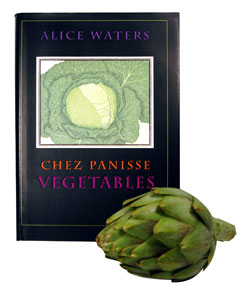 Chez
Panisse Vegetables is a great companion for approaching
the growing season ahead. From "A to Z" each vegetable is
celebrated with a comprehensive introduction, followed by
recipes that showcase the produce in its best light. Chez Panisse, for those unfamiliar with
the tradition, is a restaurant founded in 1971 in Berkeley,
CA. The philosophy of its founder and executive chef,
Alice Waters, is to create a food experience that allows
diners to "partake of the immediacy and excitement of
vegetables just out of the garden, fruit right off the branch
and fish straight out of the sea." Chez Panisse was an
early proponent of sustainable agriculture and has been the
epicenter for the trend of fresh, locally-sourced food
prepared exquisitely. Chez Panisse has been the coveted
training ground for many of today's chefs and the source of
pride for those involved in creating and sustaining the
tradition. Alice Waters is an icon in
the culinary world with numerous accomplishments and
achievements to her credit. Chez
Panisse Vegetables is one of those books that is
equally at home on the nightstand as in the kitchen. The
color linocut images that illustrate the book are beautiful
works of art to be savored along with the
recipes. Chez
Panisse Vegetables is a great companion for approaching
the growing season ahead. From "A to Z" each vegetable is
celebrated with a comprehensive introduction, followed by
recipes that showcase the produce in its best light. Chez Panisse, for those unfamiliar with
the tradition, is a restaurant founded in 1971 in Berkeley,
CA. The philosophy of its founder and executive chef,
Alice Waters, is to create a food experience that allows
diners to "partake of the immediacy and excitement of
vegetables just out of the garden, fruit right off the branch
and fish straight out of the sea." Chez Panisse was an
early proponent of sustainable agriculture and has been the
epicenter for the trend of fresh, locally-sourced food
prepared exquisitely. Chez Panisse has been the coveted
training ground for many of today's chefs and the source of
pride for those involved in creating and sustaining the
tradition. Alice Waters is an icon in
the culinary world with numerous accomplishments and
achievements to her credit. Chez
Panisse Vegetables is one of those books that is
equally at home on the nightstand as in the kitchen. The
color linocut images that illustrate the book are beautiful
works of art to be savored along with the
recipes.
|
Artichoke
Recipes
|
Recipes excerpted from Chez
Panisse Vegetables by Alice Waters. Published by
HarperCollins Publishers, Inc. Copyright 1996. Reprinted
with permission. All rights reserved.
Artichoke
and Pink Grapefruit Salad
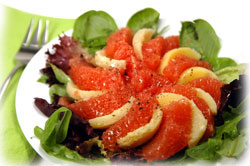 This salad is the perfect side for
the transition into spring. The primary ingredients bridge the
seasons with winter's pink grapefruit and spring's artichoke
bottoms. The bold pink of the fruit and the subtle green
of the artichoke interlaced on the plate make an attractive
visual presentation. The dressing is simple - your best, most
flavorful olive oil and fresh cracked pepper. The citrus
bursts in the mouth with each bite and blends with the
artichokes' unique flavor. Use the bottoms of freshly cooked
artichokes, or in a pinch, a can of artichoke
bottoms. This salad is the perfect side for
the transition into spring. The primary ingredients bridge the
seasons with winter's pink grapefruit and spring's artichoke
bottoms. The bold pink of the fruit and the subtle green
of the artichoke interlaced on the plate make an attractive
visual presentation. The dressing is simple - your best, most
flavorful olive oil and fresh cracked pepper. The citrus
bursts in the mouth with each bite and blends with the
artichokes' unique flavor. Use the bottoms of freshly cooked
artichokes, or in a pinch, a can of artichoke
bottoms.
Click here to view the
recipe.
Click here for a
printable
version of the recipe (PDF
format).
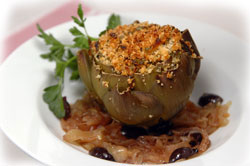 Artichokes
Baked with Anchovy Stuffing Artichokes
Baked with Anchovy Stuffing
A riff on classic
Italian stuffed artichokes, this version counts on the bed of
onions and olives to infuse their flavors into the artichoke
and the stuffing. The stuffing is a simple mix of bread
crumbs, lemon, parsley and a hint of anchovy. The tender
artichokes are stunning presentations on the dinner
plate. Serve with wedges of lemon and enjoy each leaf as
you work toward the prize at the center.
Click here to view the
recipe.
Click here for a
printable
version of the recipe (PDF
format).
Artichoke
Ragout with New Potatoes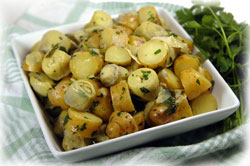
Another celebration of spring,
this combination of artichokes, new potatoes, and spring
onions is a new favorite of ours. Lightly sautéed onions start
the dish with artichoke hearts and cooked potatoes added in
succession. A smooth, natural sauce forms from the
vegetables. It's hearty, springtime fare worthy of
casual supper or a formal dinner.
Click here to view the
recipe.
Click here for a
printable
version of the recipe (PDF
format).
|
Bridal
Registry
|
Wedding
season in quickly approaching. Join us in celebrating the
engagements and pending nuptials for the following couples
registered at Cucina Fresca in 2009:
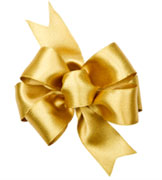
Ruth
Meyer and Tim Feldman
Wedding Date: June 27th
2009
Korrie Vance
and Shaun Hornbarger
Wedding Date: July
18th 2009
Holly
Gilbertson and Brett Hoffman
Wedding Date: August
15th 2009
Wedding Registry List is available on our
website | |
| Enjoy the
beginning of spring! |
|
| |